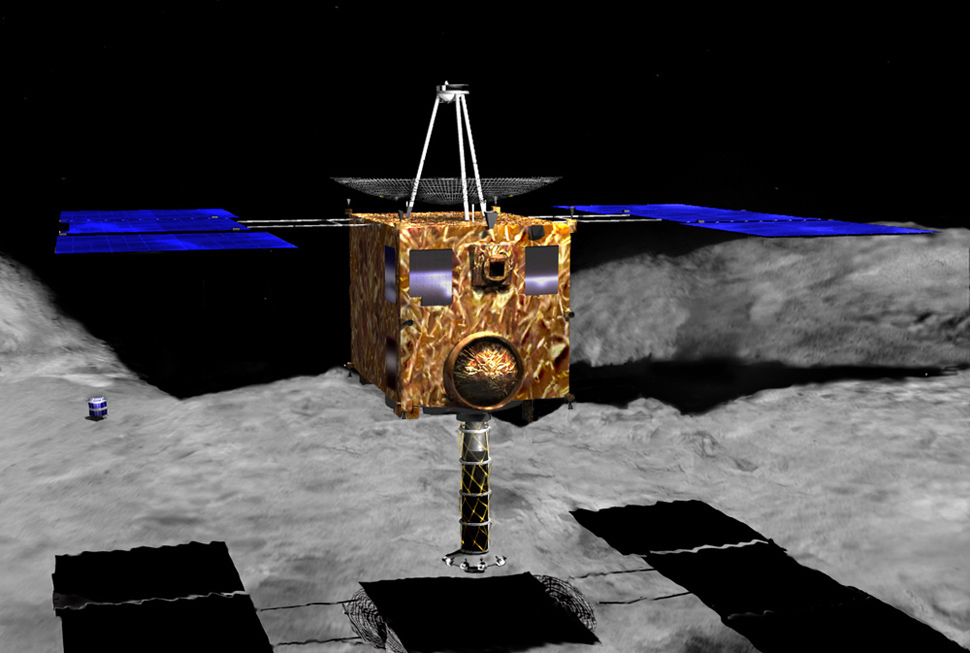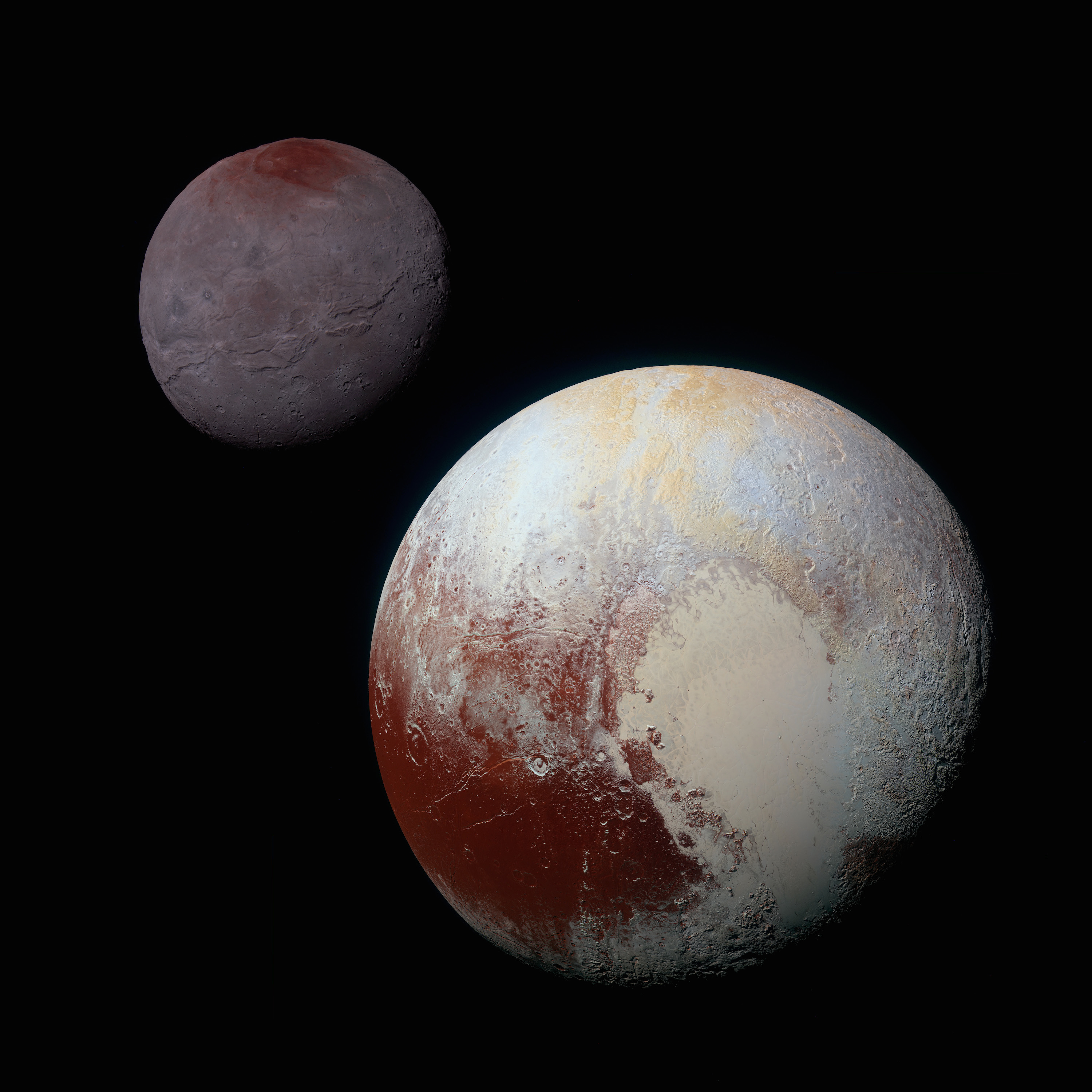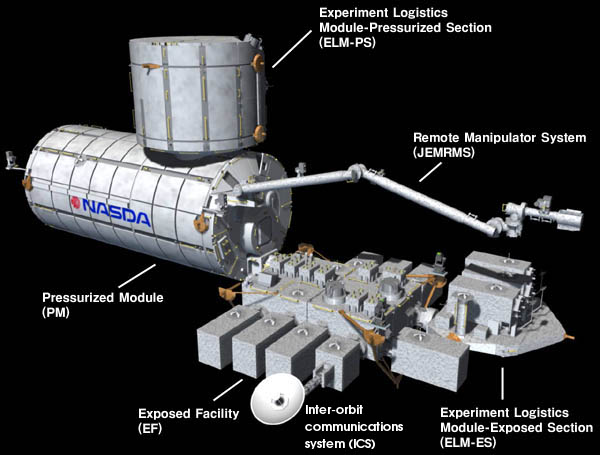|
Asteroid
An asteroid is a minor planet—an object that is neither a true planet nor an identified comet— that orbits within the inner Solar System. They are rocky, metallic, or icy bodies with no atmosphere, classified as C-type (carbonaceous), M-type (metallic), or S-type (silicaceous). The size and shape of asteroids vary significantly, ranging from small rubble piles under a kilometer across and larger than meteoroids, to Ceres, a dwarf planet almost 1000 km in diameter. A body is classified as a comet, not an asteroid, if it shows a coma (tail) when warmed by solar radiation, although recent observations suggest a continuum between these types of bodies. Of the roughly one million known asteroids, the greatest number are located between the orbits of Mars and Jupiter, approximately 2 to 4 AU from the Sun, in a region known as the main asteroid belt. The total mass of all the asteroids combined is only 3% that of Earth's Moon. The majority of main belt asteroids follow ... [...More Info...] [...Related Items...] OR: [Wikipedia] [Google] [Baidu] |
M-type Asteroid
M-type (aka M-class) asteroids are a spectral class of asteroids which appear to contain higher concentrations of metal phases (e.g. iron-nickel) than other asteroid classes, and are widely thought to be the source of iron meteorites. Definition Asteroids are classified as M-type based upon their generally featureless and flat to red-sloped absorption spectra in the visible to near-infrared and their moderate optical albedo. Along with the spectrally similar E-type and P-type asteroids (both categories E and P were formerly type-M in older systems), they are included in the larger X-type asteroid group and are distinguishable only by optical albedo: : Characteristics Composition Although widely assumed to be metal-rich (the reason for use of "M" in the classification), the evidence for a high metal content in the M-type asteroids is only indirect, though highly plausible. Their spectra are similar to those of iron meteorites and enstatite chondrites, and radar observations h ... [...More Info...] [...Related Items...] OR: [Wikipedia] [Google] [Baidu] |
Hayabusa
was a robotic spacecraft developed by the Japan Aerospace Exploration Agency (JAXA) to return a sample of material from a small near-Earth asteroid named 25143 Itokawa to Earth for further analysis. ''Hayabusa'', formerly known as MUSES-C for Mu Space Engineering Spacecraft C, was launched on 9 May 2003 and rendezvoused with Itokawa in mid-September 2005. After arriving at Itokawa, ''Hayabusa'' studied the asteroid's shape, spin, topography, color, composition, density, and history. In November 2005, it landed on the asteroid and collected samples in the form of tiny grains of asteroidal material, which were returned to Earth aboard the spacecraft on 13 June 2010. The spacecraft also carried a detachable minilander, ''MINERVA'', which failed to reach the surface. Mission firsts Other spacecraft, notably '' Galileo'' and '' NEAR Shoemaker'' (both launched by NASA), had visited asteroids before, but the ''Hayabusa'' mission was the first attempt to return an asteroid s ... [...More Info...] [...Related Items...] OR: [Wikipedia] [Google] [Baidu] |
Asteroid Belt
The asteroid belt is a torus-shaped region in the Solar System, located roughly between the orbits of the planets Jupiter and Mars. It contains a great many solid, irregularly shaped bodies, of many sizes, but much smaller than planets, called asteroids or minor planets. This asteroid belt is also called the main asteroid belt or main belt to distinguish it from other asteroid populations in the Solar System such as near-Earth asteroids and trojan asteroids. The asteroid belt is the smallest and innermost known circumstellar disc in the Solar System. About 60% of its mass is contained in the four largest asteroids: Ceres, Vesta, Pallas, and Hygiea. The total mass of the asteroid belt is calculated to be 3% that of the Moon. Ceres, the only object in the asteroid belt large enough to be a dwarf planet, is about 950 km in diameter, whereas Vesta, Pallas, and Hygiea have mean diameters less than 600 km. The remaining bodies range down to the size of a dust particl ... [...More Info...] [...Related Items...] OR: [Wikipedia] [Google] [Baidu] |
List Of Minor Planets And Comets Visited By Spacecraft
The following tables list all minor planets and comets that have been visited by robotic spacecraft. List of minor planets visited by spacecraft A total of 17 minor planets ( asteroids, dwarf planets, and Kuiper belt objects) have been visited by space probes. Moons (not directly orbiting the Sun) and planets are not minor planets and thus are not included in the table below. File:Small Asteroids and Comets Visited by Spacecraft.jpg, Minor planets and comets visited by spacecraft as of 2019 (except Pluto, Ceres, and Vesta), to scale File:Asteroidsscale.jpg, The comparative sizes of the first eight asteroids visited by spacecraft Incidental flybys In addition to the above listed objects, four asteroids have been imaged by spacecraft at distances too large to resolve features (over 100,000 km), and are labeled as such. List of comets visited by spacecraft Spacecraft visited by comets Comet C/2013 A1 passed close by planet Mars in October 2014, closer than t ... [...More Info...] [...Related Items...] OR: [Wikipedia] [Google] [Baidu] |
Dwarf Planet
A dwarf planet is a small planetary-mass object that is in direct orbit of the Sun, smaller than any of the eight classical planets but still a world in its own right. The prototypical dwarf planet is Pluto. The interest of dwarf planets to planetary geologists is that they may be geologically active bodies, an expectation that was borne out in 2015 by the '' Dawn'' mission to and the '' New Horizons'' mission to Pluto. Astronomers are in general agreement that at least the nine largest candidates are dwarf planets: Pluto, , , , , , , , and . Of these and the tenth-largest candidate , all but Sedna have either been visited by spacecraft (Pluto and Ceres) or have at least one known moon (Pluto, Eris, Haumea, Makemake, Gonggong, Quaoar, Orcus, and Salacia), which allows their masses and thus an estimate of their densities to be determined. Mass and density in turn can be fit into geophysical models in an attempt to determine the nature of these worlds. Some astronomers includ ... [...More Info...] [...Related Items...] OR: [Wikipedia] [Google] [Baidu] |
1 Ceres
Ceres (; minor-planet designation: 1 Ceres) is a dwarf planet in the asteroid belt between the orbits of Mars and Jupiter. It was the first asteroid discovered, on 1 January 1801, by Giuseppe Piazzi at Palermo Astronomical Observatory in Sicily and announced as a new planet. Ceres was later classified as an asteroid and then a dwarf planetthe only one always inside Neptune's orbit. Ceres's small size means that even at its brightest, it is too dim to be seen by the naked eye, except under extremely dark skies. Its apparent magnitude ranges from 6.7 to 9.3, peaking at opposition (when it is closest to Earth) once every 15- to 16-month synodic period. As a result, its surface features are barely visible even with the most powerful telescopes, and little was known about it until the robotic NASA spacecraft ''Dawn'' approached Ceres for its orbital mission in 2015. ''Dawn'' found Ceres's surface to be a mixture of water ice, and hydrated minerals such as carbonates and cla ... [...More Info...] [...Related Items...] OR: [Wikipedia] [Google] [Baidu] |
4 Vesta
Vesta ( minor-planet designation: 4 Vesta) is one of the largest objects in the asteroid belt, with a mean diameter of . It was discovered by the German astronomer Heinrich Wilhelm Matthias Olbers on 29 March 1807 and is named after Vesta, the virgin goddess of home and hearth from Roman mythology. Vesta is thought to be the second-largest asteroid, both by mass and by volume, after the dwarf planet Ceres, though in volume it overlaps with the uncertainty in the measurements of 2 Pallas.Marsset, M., Brož, M., Vernazza, P. et al. The violent collisional history of aqueously evolved (2) Pallas. Nat Astron 4, 569–576 (2020). https://doi.org/10.1038/s41550-019-1007-5 Measurements give it a nominal volume only slightly larger than that of Pallas (about 5% greater, which is the magnitude of the uncertainties in measurement), but it is 25% to 30% more massive. It constitutes an estimated 9% of the mass of the asteroid belt. Vesta is the only known remaining rocky protoplanet ( ... [...More Info...] [...Related Items...] OR: [Wikipedia] [Google] [Baidu] |
Dawn (spacecraft)
''Dawn'' is a retired space probe that was launched by NASA in September 2007 with the mission of studying two of the three known protoplanets of the asteroid belt: Vesta and Ceres. In the fulfillment of that mission—the ninth in NASA's Discovery Program—''Dawn'' entered orbit around Vesta on July 16, 2011, and completed a 14-month survey mission before leaving for Ceres in late 2012. It entered orbit around Ceres on March 6, 2015. In 2017, NASA announced that the planned nine-year mission would be extended until the probe's hydrazine fuel supply was depleted. On November 1, 2018, NASA announced that ''Dawn'' had depleted its hydrazine, and the mission was ended. The spacecraft is currently in a derelict, but stable, orbit around Ceres. ''Dawn'' is the first spacecraft to orbit two extraterrestrial bodies, the first spacecraft to visit either Vesta or Ceres, and the first to orbit a dwarf planet. The ''Dawn'' mission was managed by NASA's Jet Propulsion Laboratory, w ... [...More Info...] [...Related Items...] OR: [Wikipedia] [Google] [Baidu] |
NEAR Shoemaker
''Near Earth Asteroid Rendezvous – Shoemaker'' (''NEAR Shoemaker''), renamed after its 1996 launch in honor of planetary scientist Eugene Shoemaker, was a robotic space probe designed by the Johns Hopkins University Applied Physics Laboratory for NASA to study the near-Earth asteroid Eros from close orbit over a period of a year. It was the first spacecraft to successfully orbit an asteroid and also land on an asteroid. In February 2000, the mission succeeded in closing in with the asteroid and afterwards orbited it several times. On February 12, 2001, the mission succeeded in touching down on the asteroid. It was terminated just over two weeks later. The primary scientific objective of ''NEAR'' was to return data on the bulk properties, composition, mineralogy, morphology, internal mass distribution and magnetic field of Eros. Secondary objectives include studies of regolith properties, interactions with the solar wind, possible current activity as indicated by dust or ... [...More Info...] [...Related Items...] OR: [Wikipedia] [Google] [Baidu] |
JAXA
The is the Japanese national air and space agency. Through the merger of three previously independent organizations, JAXA was formed on 1 October 2003. JAXA is responsible for research, technology development and launch of satellites into orbit, and is involved in many more advanced missions such as asteroid exploration and possible human exploration of the Moon. Its motto is ''One JAXA'' and its corporate slogan is ''Explore to Realize'' (formerly ''Reaching for the skies, exploring space''). History On 1 October 2003, three organizations were merged to form the new JAXA: Japan's Institute of Space and Astronautical Science (ISAS), the National Aerospace Laboratory of Japan (NAL), and National Space Development Agency of Japan (NASDA). JAXA was formed as an Independent Administrative Institution administered by the Ministry of Education, Culture, Sports, Science and Technology (MEXT) and the Ministry of Internal Affairs and Communications (MIC). Before the merger ... [...More Info...] [...Related Items...] OR: [Wikipedia] [Google] [Baidu] |
NASA
The National Aeronautics and Space Administration (NASA ) is an independent agency of the US federal government responsible for the civil space program, aeronautics research, and space research. NASA was established in 1958, succeeding the National Advisory Committee for Aeronautics (NACA), to give the U.S. space development effort a distinctly civilian orientation, emphasizing peaceful applications in space science. NASA has since led most American space exploration, including Project Mercury, Project Gemini, the 1968-1972 Apollo Moon landing missions, the Skylab space station, and the Space Shuttle. NASA supports the International Space Station and oversees the development of the Orion spacecraft and the Space Launch System for the crewed lunar Artemis program, Commercial Crew spacecraft, and the planned Lunar Gateway space station. The agency is also responsible for the Launch Services Program, which provides oversight of launch operations and countdown m ... [...More Info...] [...Related Items...] OR: [Wikipedia] [Google] [Baidu] |
Galileo (spacecraft)
''Galileo'' was an American robotic space probe that studied the planet Jupiter and its moons, as well as the asteroids Gaspra and Ida. Named after the Italian astronomer Galileo Galilei, it consisted of an orbiter and an entry probe. It was delivered into Earth orbit on October 18, 1989, by , during STS-34. ''Galileo'' arrived at Jupiter on December 7, 1995, after gravitational assist flybys of Venus and Earth, and became the first spacecraft to orbit an outer planet. The Jet Propulsion Laboratory built the ''Galileo'' spacecraft and managed the ''Galileo'' program for NASA. West Germany Messerschmitt-Bölkow-Blohm supplied the propulsion module. NASA's Ames Research Center managed the atmospheric probe, which was built by Hughes Aircraft Company. At launch, the orbiter and probe together had a mass of and stood tall. Spacecraft are normally stabilized either by spinning around a fixed axis or by maintaining a fixed orientation with reference to the Sun and a star. '' ... [...More Info...] [...Related Items...] OR: [Wikipedia] [Google] [Baidu] |






.jpg)

